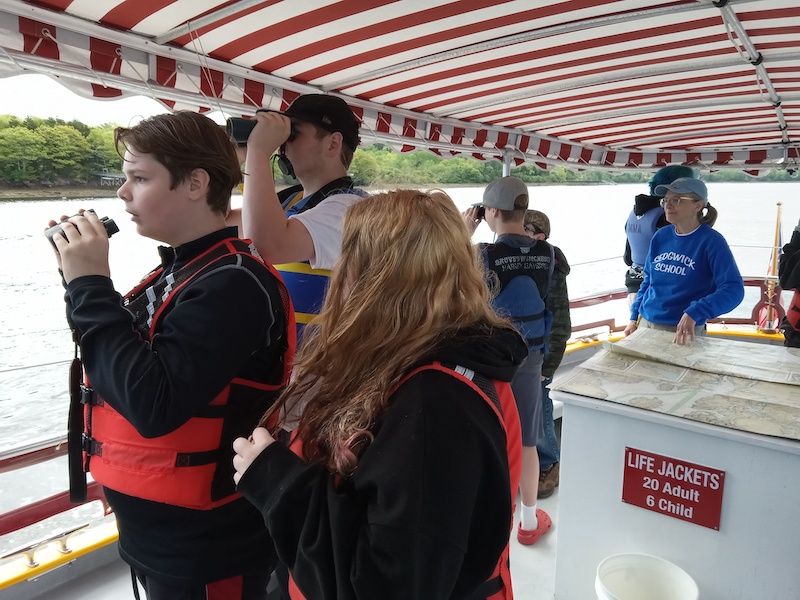By Tom Adamo
The Bagaduce Watershed Association provided fifty-eight seventh and eighth grade students from local elementary schools with power boat trips up the Bagaduce River earlier this month. Fifty-eight students and eleven adult chaperones from Brooklin, Brooksville, Castine, Penobscot and Sedgwick received scholarships from BWA for the excursions.
BWA President Tom Adamo explained the mission of the BWA and the reason for the trips to the students before leaving the Castine Dock on Lil’ Toot. “You will inherit this river from the older generation, and you will be the future stewards of it. We hope that by introducing you to the wonders of this natural world and the beauty of this river you will participate in many ways to conserve it going forward.”
The Wabanaki Nation’s use of the river was explained, as was local folklore, the hydrodynamics of the narrows and the history of the islands.
Two paper charts were placed on a locker top, and the students were taught navigation skills. They were asked to spot navigation aids in the water by number, type and color and then find the same markers on the chart. The same was done with landmarks such as church spires and towers. Explanations for reading contour lines and water depths as a navigation aid were discussed.
As we ran upriver, they were asked to locate birds and seals. On one trip they counted sixty-three Harbors Seals. “This is pupping season on the Bagaduce and if lucky we might see a mother and pup side by side.” Adamo said. It was suggested that we could identify this by head size; one larger than the other. A pair was spotted, and mother nature delivered an outstanding experience as the mother and pup caressed neck to neck. This occurred on all five trips. The words “cute, beautiful and amazing” were expressed by all onboard. The bird population was limited to Cormorants, Gulls, a small Gaggle of Geese, some Loon, and one Eagle. We also spoke of fish species, including Sturgeon.
Professor Sarah O’Malley, of Maine Maritime Academy, Ocean Studies Faculty Member, instructed the students on water temperature testing. We used four instruments and recorded the results. She taught them how to use a Spectrometer for testing salinity. The students were asked to hypothesize about possible differences as we went upriver to shallower water. Depth measurements with a sounding line were taken and compared to the boat’s electronic depth finder. We also towed a Plankton Net and the Plankton which was gathered was taken to the MMA Ocean Studies Lab and studied under microscopes. The students were fascinated by the life swimming under the lens. They saw various Diatoms, Dinoflagellates, Segmented Worms, Tunicates, Crustaceans and Copepods. The highlight was seeing a Larval Lobster. The remaining Plankton was returned to the river to conserve this valuable food source.
Funding for the scholarships was donated by members of the peninsula.






